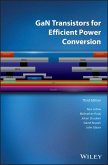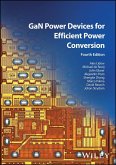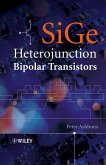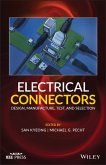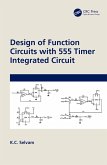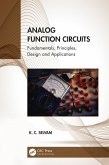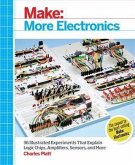Alex Lidow, Michael De Rooij, John Glaser, Alejandro Pozo, Shengke Zhang, Marco Palma, David Reusch, Johan Strydom
GaN Power Devices for Efficient Power Conversion (eBook, PDF)
113,99 €
113,99 €
inkl. MwSt.
Sofort per Download lieferbar

0 °P sammeln
113,99 €
Als Download kaufen

113,99 €
inkl. MwSt.
Sofort per Download lieferbar

0 °P sammeln
Jetzt verschenken
Alle Infos zum eBook verschenken
113,99 €
inkl. MwSt.
Sofort per Download lieferbar
Alle Infos zum eBook verschenken

0 °P sammeln
Alex Lidow, Michael De Rooij, John Glaser, Alejandro Pozo, Shengke Zhang, Marco Palma, David Reusch, Johan Strydom
GaN Power Devices for Efficient Power Conversion (eBook, PDF)
- Format: PDF
- Merkliste
- Auf die Merkliste
- Bewerten Bewerten
- Teilen
- Produkt teilen
- Produkterinnerung
- Produkterinnerung

Bitte loggen Sie sich zunächst in Ihr Kundenkonto ein oder registrieren Sie sich bei
bücher.de, um das eBook-Abo tolino select nutzen zu können.
Hier können Sie sich einloggen
Hier können Sie sich einloggen
Sie sind bereits eingeloggt. Klicken Sie auf 2. tolino select Abo, um fortzufahren.

Bitte loggen Sie sich zunächst in Ihr Kundenkonto ein oder registrieren Sie sich bei bücher.de, um das eBook-Abo tolino select nutzen zu können.
An up-to-date and concise review of GaN transistor design and applications
In the newly revised fourth edition of GaN Power Devices for Efficient Power Conversion, a team of distinguished researchers and practicing engineers deliver a concise and effective new guide to designing small, energy-efficient, and inexpensive products with GaN transistors. This new edition covers all relevant new GaN technology advancements, allowing students and practicing engineers to get, and stay ahead of, the curve with GaN device and circuit technology.
You'll explore applications including DC to DC…mehr
- Geräte: PC
- mit Kopierschutz
- eBook Hilfe
- Größe: 77.34MB
Andere Kunden interessierten sich auch für
![GaN Transistors for Efficient Power Conversion (eBook, PDF) GaN Transistors for Efficient Power Conversion (eBook, PDF)]() Alex LidowGaN Transistors for Efficient Power Conversion (eBook, PDF)106,99 €
Alex LidowGaN Transistors for Efficient Power Conversion (eBook, PDF)106,99 €![GaN Power Devices for Efficient Power Conversion (eBook, ePUB) GaN Power Devices for Efficient Power Conversion (eBook, ePUB)]() Alex LidowGaN Power Devices for Efficient Power Conversion (eBook, ePUB)113,99 €
Alex LidowGaN Power Devices for Efficient Power Conversion (eBook, ePUB)113,99 €![SiGe Heterojunction Bipolar Transistors (eBook, PDF) SiGe Heterojunction Bipolar Transistors (eBook, PDF)]() Peter AshburnSiGe Heterojunction Bipolar Transistors (eBook, PDF)125,99 €
Peter AshburnSiGe Heterojunction Bipolar Transistors (eBook, PDF)125,99 €![Electrical Connectors (eBook, PDF) Electrical Connectors (eBook, PDF)]() Electrical Connectors (eBook, PDF)125,99 €
Electrical Connectors (eBook, PDF)125,99 €![Design of Function Circuits with 555 Timer Integrated Circuit (eBook, PDF) Design of Function Circuits with 555 Timer Integrated Circuit (eBook, PDF)]() K. C. SelvamDesign of Function Circuits with 555 Timer Integrated Circuit (eBook, PDF)51,95 €
K. C. SelvamDesign of Function Circuits with 555 Timer Integrated Circuit (eBook, PDF)51,95 €![Analog Function Circuits (eBook, PDF) Analog Function Circuits (eBook, PDF)]() K. C. SelvamAnalog Function Circuits (eBook, PDF)50,95 €
K. C. SelvamAnalog Function Circuits (eBook, PDF)50,95 €![Make: More Electronics (eBook, PDF) Make: More Electronics (eBook, PDF)]() Charles PlattMake: More Electronics (eBook, PDF)20,95 €
Charles PlattMake: More Electronics (eBook, PDF)20,95 €-
-
-
An up-to-date and concise review of GaN transistor design and applications
In the newly revised fourth edition of GaN Power Devices for Efficient Power Conversion, a team of distinguished researchers and practicing engineers deliver a concise and effective new guide to designing small, energy-efficient, and inexpensive products with GaN transistors. This new edition covers all relevant new GaN technology advancements, allowing students and practicing engineers to get, and stay ahead of, the curve with GaN device and circuit technology.
You'll explore applications including DC to DC converters, solar inverters, motor drive controllers, satellite electronics, and LiDAR devices. The 4th edition offers critical updates for space applications, vertical GaN, and driving transistors and integrated circuits. New chapters on reliability testing advancements, device wear out mechanisms, thermal management, and the latest developments in monolithic integration round out the book.
Readers will also find:
Perfect for practicing power conversion engineers, GaN Power Devices for Efficient Power Conversion will also benefit electrical engineering students and device scientists in the field of power electronics.
In the newly revised fourth edition of GaN Power Devices for Efficient Power Conversion, a team of distinguished researchers and practicing engineers deliver a concise and effective new guide to designing small, energy-efficient, and inexpensive products with GaN transistors. This new edition covers all relevant new GaN technology advancements, allowing students and practicing engineers to get, and stay ahead of, the curve with GaN device and circuit technology.
You'll explore applications including DC to DC converters, solar inverters, motor drive controllers, satellite electronics, and LiDAR devices. The 4th edition offers critical updates for space applications, vertical GaN, and driving transistors and integrated circuits. New chapters on reliability testing advancements, device wear out mechanisms, thermal management, and the latest developments in monolithic integration round out the book.
Readers will also find:
- The latest updates on significant technology improvements, like integrated circuits, reliability studies, and new applications
- Comprehensive explorations of integrated circuit construction, characteristics, reliability results, and applications
- Practical discussions of specific circuit designs, layout, and thermal dissipation when designing power conversion systems
- Chapters written by practicing expert leaders in the power semiconductor field and industry pioneers
Perfect for practicing power conversion engineers, GaN Power Devices for Efficient Power Conversion will also benefit electrical engineering students and device scientists in the field of power electronics.
Dieser Download kann aus rechtlichen Gründen nur mit Rechnungsadresse in D ausgeliefert werden.
Produktdetails
- Produktdetails
- Verlag: John Wiley & Sons
- Seitenzahl: 499
- Erscheinungstermin: 27. Dezember 2024
- Englisch
- ISBN-13: 9781394286966
- Artikelnr.: 72710580
- Verlag: John Wiley & Sons
- Seitenzahl: 499
- Erscheinungstermin: 27. Dezember 2024
- Englisch
- ISBN-13: 9781394286966
- Artikelnr.: 72710580
- Herstellerkennzeichnung Die Herstellerinformationen sind derzeit nicht verfügbar.
Alex Lidow is the CEO and Co-founder of Efficient Power Conversion.
Michael de Rooij is Vice President of Applications Engineering at Efficient Power Conversion.
John Glaser is Director of Applications at Efficient Power Conversion.
Alejandro Pozo is a Senior Applications Engineer at Efficient Power Conversion.
Shengke Zhang is Vice President of Product Reliability at Efficient Power Conversion.
Marco Palma is a Senior FAE Manager based in Europe.
David Reusch is a Systems Engineer, Kilby Labs, Texas Instruments, USA.
Johan Strydom is Advanced Development Manager, Kilby Labs, Texas Instruments, USA.
Michael de Rooij is Vice President of Applications Engineering at Efficient Power Conversion.
John Glaser is Director of Applications at Efficient Power Conversion.
Alejandro Pozo is a Senior Applications Engineer at Efficient Power Conversion.
Shengke Zhang is Vice President of Product Reliability at Efficient Power Conversion.
Marco Palma is a Senior FAE Manager based in Europe.
David Reusch is a Systems Engineer, Kilby Labs, Texas Instruments, USA.
Johan Strydom is Advanced Development Manager, Kilby Labs, Texas Instruments, USA.
Foreword xi
Acknowledgments xiii
1 GaN Technology Overview 1
1.1 Silicon Power MOSFETs: 1976-2010 1
1.2 The GaN Journey Begins 2
1.3 GaN and SiC Compared with Silicon 2
1.4 The Basic GaN Transistor Structure 6
1.5 Building a GaN HEMT Transistor 11
1.6 GaN Integrated Circuits 15
1.7 Summary 21
References 22
2 GaN Transistor Electrical Characteristics 25
2.1 Introduction 25
2.2 Device Ratings 25
2.3 Gate Voltage 30
2.4 On-Resistance (R DS(on)) 31
2.5 Threshold Voltage 34
2.6 Capacitance and Charge 35
2.7 Reverse Conduction 38
2.8 Thermal Characteristics 40
2.9 Summary 42
References 42
3 Driving GaN Transistors 45
3.1 Introduction 45
3.2 Gate Drive Voltage 47
3.3 Gate Drive Resistance 48
3.4 dv/dt Considerations 50
3.5 di/dt Considerations 53
3.6 Bootstrapping and Floating Supplies 56
3.7 Transient Immunity 59
3.8 Gate Drivers and Controllers for Enhancement-Mode GaN Transistors 61
3.9 Cascode, Direct Drive, and Higher-Voltage Configurations 61
3.10 Using GaN Transistors with Drivers or Controllers Designed for Si
MOSFETs 67
3.11 Driving GaN ICs 68
3.12 Summary 69
References 70
4 Layout Considerations for GaN Transistor Circuits 75
4.1 Introduction 75
4.2 Origin of Parasitic Inductance 76
4.3 Minimizing Common-Source Inductance 77
4.4 Minimizing Power-Loop Inductance in a Half-Bridge Configuration 79
4.5 Paralleling GaN Transistors 85
4.6 Summary 93
References 93
5 GaN Reliability 95
5.1 Introduction 95
5.2 Getting Started with GaN Reliability 95
5.3 Determining Wear-Out Mechanisms Using Test-to-Fail Methodology 95
5.4 Using Test-to-Fail Results to Predict Device Lifetime in a System 98
5.5 Wear-Out Mechanisms 99
5.6 Mission-Specific Reliability Predictions 133
5.7 Summary 150
References 150
6 Thermal Management of GaN Devices 155
6.1 Introduction 155
6.2 Thermal Equivalent Circuits 155
6.3 Cooling Methods 160
6.4 System-Level Thermal Overview: Single FET 163
6.5 System-Level Thermal Analysis: Multiple FETs 176
6.6 Experimental Thermal Examples 182
6.7 Summary 191
References 191
7 Hard-Switching Topologies 195
7.1 Introduction 195
7.2 Hard-Switching Loss Analysis 196
7.3 External Factors Impacting Hard-Switching Losses 217
7.4 Frequency Impact on Magnetics 223
7.5 Buck Converter Example 224
7.6 Summary 245
References 245
8 Resonant and Soft-Switching Converters 249
8.1 Introduction 249
8.2 Resonant and Soft-Switching Techniques 249
8.3 Key Device Parameters for Resonant and Soft-Switching Applications 254
8.4 High-Frequency Resonant Bus Converter Example 261
8.5 Summary 269
References 271
9 RF Performance 273
9.1 Introduction 273
9.2 Differences Between RF and Switching Transistors 275
9.3 RF Basics 276
9.4 RF Transistor Metrics 277
9.5 Amplifier Design Using Small-Signal s-Parameters 284
9.6 Amplifier Design Example 285
9.7 Summary 292
References 292
10 DC-DC Power Conversion 295
10.1 Introduction 295
10.2 DC-DC Converter Examples 295
10.3 Summary 317
References 318
11 Multilevel Converters 321
11.1 Introduction 321
11.2 Benefits of Multilevel Converters 321
11.3 Experimental Examples 338
11.4 Summary 348
References 348
12 Class D Audio Amplifiers 351
12.1 Introduction 351
12.2 GaN Transistor Class D Audio Amplifier Example 355
12.3 Summary 364
References 364
13 High Current Nanosecond Laser Drivers for Lidar 367
13.1 Introduction to Light Detection and Ranging (Lidar) 367
13.2 Pulsed Laser Driver Overview 368
13.3 Basic Design Process 378
13.4 Hardware Driver Design 384
13.5 Experimental Results 388
13.6 Additional Considerations for Laser Transmitter Design 394
13.7 Summary 399
References 399
14 Motor Drives 403
14.1 Introduction 403
14.2 Motor Types 403
14.3 Inverter 403
14.4 Typical Applications 404
14.5 Voltage Source Inverters and Motor Control Basics 404
14.6 Field-Oriented Control Basics 408
14.7 Current Measurement Techniques 410
14.8 Power Dissipation in Motor and Inverter 411
14.9 Silicon Inverter Limitations 412
14.10 LC Filter Dissipation 412
14.11 Torque Sixth Harmonic Dissipation 413
14.12 GaN Advantage 413
14.13 GaN Switching Behavior 413
14.14 Dead Time Elimination Effect 414
14.15 PWM Frequency Increase Effect 415
14.16 Layout Considerations for Motor Drives 420
14.17 GaN Devices for Motor Applications 421
14.18 Application Examples 421
14.19 Summary 430
References 430
15 GaN Transistors and Integrated Circuits for Space Applications 433
15.1 Introduction 433
15.2 Failure Mechanisms in Electronic Components Used in Space Applications
433
15.3 Standards for Radiation Exposure and Tolerance 434
15.4 Gamma Radiation 434
15.5 Neutron Radiation (Displacement Damage) 437
15.6 Single-Event Effects (SEE) Testing 438
15.7 Performance Comparison Between GaN Transistors and Rad-Hard Si MOSFETs
440
15.8 GaN Integrated Circuits 441
15.9 Summary 445
References 445
16 Replacing Silicon Power MOSFETs 449
16.1 Introduction: GaN, Rapid Growth/Great Future 449
16.2 New Capabilities Enabled by GaN Devices 449
16.3 GaN Devices Are Easy to Use 453
16.4 GaN Cost Reduction over Time 454
16.5 GaN Devices Are Reliable 454
16.6 Future Direction of GaN Devices 455
16.7 Summary 456
References 456
Appendix Glossary of Terms 459
Index 477
Acknowledgments xiii
1 GaN Technology Overview 1
1.1 Silicon Power MOSFETs: 1976-2010 1
1.2 The GaN Journey Begins 2
1.3 GaN and SiC Compared with Silicon 2
1.4 The Basic GaN Transistor Structure 6
1.5 Building a GaN HEMT Transistor 11
1.6 GaN Integrated Circuits 15
1.7 Summary 21
References 22
2 GaN Transistor Electrical Characteristics 25
2.1 Introduction 25
2.2 Device Ratings 25
2.3 Gate Voltage 30
2.4 On-Resistance (R DS(on)) 31
2.5 Threshold Voltage 34
2.6 Capacitance and Charge 35
2.7 Reverse Conduction 38
2.8 Thermal Characteristics 40
2.9 Summary 42
References 42
3 Driving GaN Transistors 45
3.1 Introduction 45
3.2 Gate Drive Voltage 47
3.3 Gate Drive Resistance 48
3.4 dv/dt Considerations 50
3.5 di/dt Considerations 53
3.6 Bootstrapping and Floating Supplies 56
3.7 Transient Immunity 59
3.8 Gate Drivers and Controllers for Enhancement-Mode GaN Transistors 61
3.9 Cascode, Direct Drive, and Higher-Voltage Configurations 61
3.10 Using GaN Transistors with Drivers or Controllers Designed for Si
MOSFETs 67
3.11 Driving GaN ICs 68
3.12 Summary 69
References 70
4 Layout Considerations for GaN Transistor Circuits 75
4.1 Introduction 75
4.2 Origin of Parasitic Inductance 76
4.3 Minimizing Common-Source Inductance 77
4.4 Minimizing Power-Loop Inductance in a Half-Bridge Configuration 79
4.5 Paralleling GaN Transistors 85
4.6 Summary 93
References 93
5 GaN Reliability 95
5.1 Introduction 95
5.2 Getting Started with GaN Reliability 95
5.3 Determining Wear-Out Mechanisms Using Test-to-Fail Methodology 95
5.4 Using Test-to-Fail Results to Predict Device Lifetime in a System 98
5.5 Wear-Out Mechanisms 99
5.6 Mission-Specific Reliability Predictions 133
5.7 Summary 150
References 150
6 Thermal Management of GaN Devices 155
6.1 Introduction 155
6.2 Thermal Equivalent Circuits 155
6.3 Cooling Methods 160
6.4 System-Level Thermal Overview: Single FET 163
6.5 System-Level Thermal Analysis: Multiple FETs 176
6.6 Experimental Thermal Examples 182
6.7 Summary 191
References 191
7 Hard-Switching Topologies 195
7.1 Introduction 195
7.2 Hard-Switching Loss Analysis 196
7.3 External Factors Impacting Hard-Switching Losses 217
7.4 Frequency Impact on Magnetics 223
7.5 Buck Converter Example 224
7.6 Summary 245
References 245
8 Resonant and Soft-Switching Converters 249
8.1 Introduction 249
8.2 Resonant and Soft-Switching Techniques 249
8.3 Key Device Parameters for Resonant and Soft-Switching Applications 254
8.4 High-Frequency Resonant Bus Converter Example 261
8.5 Summary 269
References 271
9 RF Performance 273
9.1 Introduction 273
9.2 Differences Between RF and Switching Transistors 275
9.3 RF Basics 276
9.4 RF Transistor Metrics 277
9.5 Amplifier Design Using Small-Signal s-Parameters 284
9.6 Amplifier Design Example 285
9.7 Summary 292
References 292
10 DC-DC Power Conversion 295
10.1 Introduction 295
10.2 DC-DC Converter Examples 295
10.3 Summary 317
References 318
11 Multilevel Converters 321
11.1 Introduction 321
11.2 Benefits of Multilevel Converters 321
11.3 Experimental Examples 338
11.4 Summary 348
References 348
12 Class D Audio Amplifiers 351
12.1 Introduction 351
12.2 GaN Transistor Class D Audio Amplifier Example 355
12.3 Summary 364
References 364
13 High Current Nanosecond Laser Drivers for Lidar 367
13.1 Introduction to Light Detection and Ranging (Lidar) 367
13.2 Pulsed Laser Driver Overview 368
13.3 Basic Design Process 378
13.4 Hardware Driver Design 384
13.5 Experimental Results 388
13.6 Additional Considerations for Laser Transmitter Design 394
13.7 Summary 399
References 399
14 Motor Drives 403
14.1 Introduction 403
14.2 Motor Types 403
14.3 Inverter 403
14.4 Typical Applications 404
14.5 Voltage Source Inverters and Motor Control Basics 404
14.6 Field-Oriented Control Basics 408
14.7 Current Measurement Techniques 410
14.8 Power Dissipation in Motor and Inverter 411
14.9 Silicon Inverter Limitations 412
14.10 LC Filter Dissipation 412
14.11 Torque Sixth Harmonic Dissipation 413
14.12 GaN Advantage 413
14.13 GaN Switching Behavior 413
14.14 Dead Time Elimination Effect 414
14.15 PWM Frequency Increase Effect 415
14.16 Layout Considerations for Motor Drives 420
14.17 GaN Devices for Motor Applications 421
14.18 Application Examples 421
14.19 Summary 430
References 430
15 GaN Transistors and Integrated Circuits for Space Applications 433
15.1 Introduction 433
15.2 Failure Mechanisms in Electronic Components Used in Space Applications
433
15.3 Standards for Radiation Exposure and Tolerance 434
15.4 Gamma Radiation 434
15.5 Neutron Radiation (Displacement Damage) 437
15.6 Single-Event Effects (SEE) Testing 438
15.7 Performance Comparison Between GaN Transistors and Rad-Hard Si MOSFETs
440
15.8 GaN Integrated Circuits 441
15.9 Summary 445
References 445
16 Replacing Silicon Power MOSFETs 449
16.1 Introduction: GaN, Rapid Growth/Great Future 449
16.2 New Capabilities Enabled by GaN Devices 449
16.3 GaN Devices Are Easy to Use 453
16.4 GaN Cost Reduction over Time 454
16.5 GaN Devices Are Reliable 454
16.6 Future Direction of GaN Devices 455
16.7 Summary 456
References 456
Appendix Glossary of Terms 459
Index 477
Foreword xi
Acknowledgments xiii
1 GaN Technology Overview 1
1.1 Silicon Power MOSFETs: 1976-2010 1
1.2 The GaN Journey Begins 2
1.3 GaN and SiC Compared with Silicon 2
1.4 The Basic GaN Transistor Structure 6
1.5 Building a GaN HEMT Transistor 11
1.6 GaN Integrated Circuits 15
1.7 Summary 21
References 22
2 GaN Transistor Electrical Characteristics 25
2.1 Introduction 25
2.2 Device Ratings 25
2.3 Gate Voltage 30
2.4 On-Resistance (R DS(on)) 31
2.5 Threshold Voltage 34
2.6 Capacitance and Charge 35
2.7 Reverse Conduction 38
2.8 Thermal Characteristics 40
2.9 Summary 42
References 42
3 Driving GaN Transistors 45
3.1 Introduction 45
3.2 Gate Drive Voltage 47
3.3 Gate Drive Resistance 48
3.4 dv/dt Considerations 50
3.5 di/dt Considerations 53
3.6 Bootstrapping and Floating Supplies 56
3.7 Transient Immunity 59
3.8 Gate Drivers and Controllers for Enhancement-Mode GaN Transistors 61
3.9 Cascode, Direct Drive, and Higher-Voltage Configurations 61
3.10 Using GaN Transistors with Drivers or Controllers Designed for Si
MOSFETs 67
3.11 Driving GaN ICs 68
3.12 Summary 69
References 70
4 Layout Considerations for GaN Transistor Circuits 75
4.1 Introduction 75
4.2 Origin of Parasitic Inductance 76
4.3 Minimizing Common-Source Inductance 77
4.4 Minimizing Power-Loop Inductance in a Half-Bridge Configuration 79
4.5 Paralleling GaN Transistors 85
4.6 Summary 93
References 93
5 GaN Reliability 95
5.1 Introduction 95
5.2 Getting Started with GaN Reliability 95
5.3 Determining Wear-Out Mechanisms Using Test-to-Fail Methodology 95
5.4 Using Test-to-Fail Results to Predict Device Lifetime in a System 98
5.5 Wear-Out Mechanisms 99
5.6 Mission-Specific Reliability Predictions 133
5.7 Summary 150
References 150
6 Thermal Management of GaN Devices 155
6.1 Introduction 155
6.2 Thermal Equivalent Circuits 155
6.3 Cooling Methods 160
6.4 System-Level Thermal Overview: Single FET 163
6.5 System-Level Thermal Analysis: Multiple FETs 176
6.6 Experimental Thermal Examples 182
6.7 Summary 191
References 191
7 Hard-Switching Topologies 195
7.1 Introduction 195
7.2 Hard-Switching Loss Analysis 196
7.3 External Factors Impacting Hard-Switching Losses 217
7.4 Frequency Impact on Magnetics 223
7.5 Buck Converter Example 224
7.6 Summary 245
References 245
8 Resonant and Soft-Switching Converters 249
8.1 Introduction 249
8.2 Resonant and Soft-Switching Techniques 249
8.3 Key Device Parameters for Resonant and Soft-Switching Applications 254
8.4 High-Frequency Resonant Bus Converter Example 261
8.5 Summary 269
References 271
9 RF Performance 273
9.1 Introduction 273
9.2 Differences Between RF and Switching Transistors 275
9.3 RF Basics 276
9.4 RF Transistor Metrics 277
9.5 Amplifier Design Using Small-Signal s-Parameters 284
9.6 Amplifier Design Example 285
9.7 Summary 292
References 292
10 DC-DC Power Conversion 295
10.1 Introduction 295
10.2 DC-DC Converter Examples 295
10.3 Summary 317
References 318
11 Multilevel Converters 321
11.1 Introduction 321
11.2 Benefits of Multilevel Converters 321
11.3 Experimental Examples 338
11.4 Summary 348
References 348
12 Class D Audio Amplifiers 351
12.1 Introduction 351
12.2 GaN Transistor Class D Audio Amplifier Example 355
12.3 Summary 364
References 364
13 High Current Nanosecond Laser Drivers for Lidar 367
13.1 Introduction to Light Detection and Ranging (Lidar) 367
13.2 Pulsed Laser Driver Overview 368
13.3 Basic Design Process 378
13.4 Hardware Driver Design 384
13.5 Experimental Results 388
13.6 Additional Considerations for Laser Transmitter Design 394
13.7 Summary 399
References 399
14 Motor Drives 403
14.1 Introduction 403
14.2 Motor Types 403
14.3 Inverter 403
14.4 Typical Applications 404
14.5 Voltage Source Inverters and Motor Control Basics 404
14.6 Field-Oriented Control Basics 408
14.7 Current Measurement Techniques 410
14.8 Power Dissipation in Motor and Inverter 411
14.9 Silicon Inverter Limitations 412
14.10 LC Filter Dissipation 412
14.11 Torque Sixth Harmonic Dissipation 413
14.12 GaN Advantage 413
14.13 GaN Switching Behavior 413
14.14 Dead Time Elimination Effect 414
14.15 PWM Frequency Increase Effect 415
14.16 Layout Considerations for Motor Drives 420
14.17 GaN Devices for Motor Applications 421
14.18 Application Examples 421
14.19 Summary 430
References 430
15 GaN Transistors and Integrated Circuits for Space Applications 433
15.1 Introduction 433
15.2 Failure Mechanisms in Electronic Components Used in Space Applications
433
15.3 Standards for Radiation Exposure and Tolerance 434
15.4 Gamma Radiation 434
15.5 Neutron Radiation (Displacement Damage) 437
15.6 Single-Event Effects (SEE) Testing 438
15.7 Performance Comparison Between GaN Transistors and Rad-Hard Si MOSFETs
440
15.8 GaN Integrated Circuits 441
15.9 Summary 445
References 445
16 Replacing Silicon Power MOSFETs 449
16.1 Introduction: GaN, Rapid Growth/Great Future 449
16.2 New Capabilities Enabled by GaN Devices 449
16.3 GaN Devices Are Easy to Use 453
16.4 GaN Cost Reduction over Time 454
16.5 GaN Devices Are Reliable 454
16.6 Future Direction of GaN Devices 455
16.7 Summary 456
References 456
Appendix Glossary of Terms 459
Index 477
Acknowledgments xiii
1 GaN Technology Overview 1
1.1 Silicon Power MOSFETs: 1976-2010 1
1.2 The GaN Journey Begins 2
1.3 GaN and SiC Compared with Silicon 2
1.4 The Basic GaN Transistor Structure 6
1.5 Building a GaN HEMT Transistor 11
1.6 GaN Integrated Circuits 15
1.7 Summary 21
References 22
2 GaN Transistor Electrical Characteristics 25
2.1 Introduction 25
2.2 Device Ratings 25
2.3 Gate Voltage 30
2.4 On-Resistance (R DS(on)) 31
2.5 Threshold Voltage 34
2.6 Capacitance and Charge 35
2.7 Reverse Conduction 38
2.8 Thermal Characteristics 40
2.9 Summary 42
References 42
3 Driving GaN Transistors 45
3.1 Introduction 45
3.2 Gate Drive Voltage 47
3.3 Gate Drive Resistance 48
3.4 dv/dt Considerations 50
3.5 di/dt Considerations 53
3.6 Bootstrapping and Floating Supplies 56
3.7 Transient Immunity 59
3.8 Gate Drivers and Controllers for Enhancement-Mode GaN Transistors 61
3.9 Cascode, Direct Drive, and Higher-Voltage Configurations 61
3.10 Using GaN Transistors with Drivers or Controllers Designed for Si
MOSFETs 67
3.11 Driving GaN ICs 68
3.12 Summary 69
References 70
4 Layout Considerations for GaN Transistor Circuits 75
4.1 Introduction 75
4.2 Origin of Parasitic Inductance 76
4.3 Minimizing Common-Source Inductance 77
4.4 Minimizing Power-Loop Inductance in a Half-Bridge Configuration 79
4.5 Paralleling GaN Transistors 85
4.6 Summary 93
References 93
5 GaN Reliability 95
5.1 Introduction 95
5.2 Getting Started with GaN Reliability 95
5.3 Determining Wear-Out Mechanisms Using Test-to-Fail Methodology 95
5.4 Using Test-to-Fail Results to Predict Device Lifetime in a System 98
5.5 Wear-Out Mechanisms 99
5.6 Mission-Specific Reliability Predictions 133
5.7 Summary 150
References 150
6 Thermal Management of GaN Devices 155
6.1 Introduction 155
6.2 Thermal Equivalent Circuits 155
6.3 Cooling Methods 160
6.4 System-Level Thermal Overview: Single FET 163
6.5 System-Level Thermal Analysis: Multiple FETs 176
6.6 Experimental Thermal Examples 182
6.7 Summary 191
References 191
7 Hard-Switching Topologies 195
7.1 Introduction 195
7.2 Hard-Switching Loss Analysis 196
7.3 External Factors Impacting Hard-Switching Losses 217
7.4 Frequency Impact on Magnetics 223
7.5 Buck Converter Example 224
7.6 Summary 245
References 245
8 Resonant and Soft-Switching Converters 249
8.1 Introduction 249
8.2 Resonant and Soft-Switching Techniques 249
8.3 Key Device Parameters for Resonant and Soft-Switching Applications 254
8.4 High-Frequency Resonant Bus Converter Example 261
8.5 Summary 269
References 271
9 RF Performance 273
9.1 Introduction 273
9.2 Differences Between RF and Switching Transistors 275
9.3 RF Basics 276
9.4 RF Transistor Metrics 277
9.5 Amplifier Design Using Small-Signal s-Parameters 284
9.6 Amplifier Design Example 285
9.7 Summary 292
References 292
10 DC-DC Power Conversion 295
10.1 Introduction 295
10.2 DC-DC Converter Examples 295
10.3 Summary 317
References 318
11 Multilevel Converters 321
11.1 Introduction 321
11.2 Benefits of Multilevel Converters 321
11.3 Experimental Examples 338
11.4 Summary 348
References 348
12 Class D Audio Amplifiers 351
12.1 Introduction 351
12.2 GaN Transistor Class D Audio Amplifier Example 355
12.3 Summary 364
References 364
13 High Current Nanosecond Laser Drivers for Lidar 367
13.1 Introduction to Light Detection and Ranging (Lidar) 367
13.2 Pulsed Laser Driver Overview 368
13.3 Basic Design Process 378
13.4 Hardware Driver Design 384
13.5 Experimental Results 388
13.6 Additional Considerations for Laser Transmitter Design 394
13.7 Summary 399
References 399
14 Motor Drives 403
14.1 Introduction 403
14.2 Motor Types 403
14.3 Inverter 403
14.4 Typical Applications 404
14.5 Voltage Source Inverters and Motor Control Basics 404
14.6 Field-Oriented Control Basics 408
14.7 Current Measurement Techniques 410
14.8 Power Dissipation in Motor and Inverter 411
14.9 Silicon Inverter Limitations 412
14.10 LC Filter Dissipation 412
14.11 Torque Sixth Harmonic Dissipation 413
14.12 GaN Advantage 413
14.13 GaN Switching Behavior 413
14.14 Dead Time Elimination Effect 414
14.15 PWM Frequency Increase Effect 415
14.16 Layout Considerations for Motor Drives 420
14.17 GaN Devices for Motor Applications 421
14.18 Application Examples 421
14.19 Summary 430
References 430
15 GaN Transistors and Integrated Circuits for Space Applications 433
15.1 Introduction 433
15.2 Failure Mechanisms in Electronic Components Used in Space Applications
433
15.3 Standards for Radiation Exposure and Tolerance 434
15.4 Gamma Radiation 434
15.5 Neutron Radiation (Displacement Damage) 437
15.6 Single-Event Effects (SEE) Testing 438
15.7 Performance Comparison Between GaN Transistors and Rad-Hard Si MOSFETs
440
15.8 GaN Integrated Circuits 441
15.9 Summary 445
References 445
16 Replacing Silicon Power MOSFETs 449
16.1 Introduction: GaN, Rapid Growth/Great Future 449
16.2 New Capabilities Enabled by GaN Devices 449
16.3 GaN Devices Are Easy to Use 453
16.4 GaN Cost Reduction over Time 454
16.5 GaN Devices Are Reliable 454
16.6 Future Direction of GaN Devices 455
16.7 Summary 456
References 456
Appendix Glossary of Terms 459
Index 477

